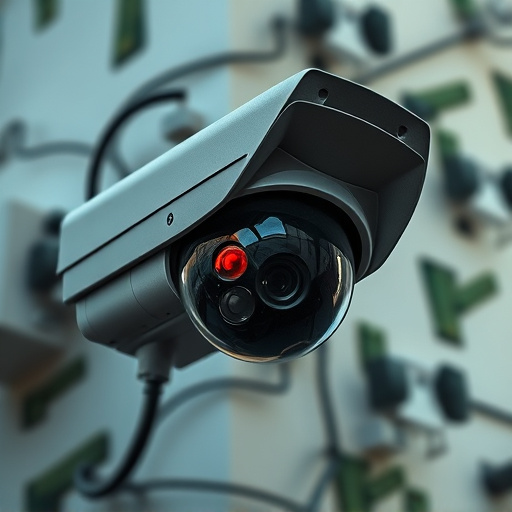Researchers strategically installed multiple fake security cameras at various heights and angles across a test site to mimic real surveillance equipment. These dummy cameras have proven effective in reducing criminal activity through psychological deterrence, offering a cost-efficient solution for enhanced safety without real systems. Long-term studies show they significantly impact criminal behavior, encouraging offenders to avoid targeted areas due to increased surveillance.
“This study investigates the effectiveness of dummy camera deterrents in reducing criminal activities. Our research methodology involved strategically installing multiple fake security cameras in high-crime areas to observe behavioral changes. Initial observations reveal a notable decline in suspicious activities, suggesting that these visual reminders significantly impact potential criminals’ decisions. Through interviews with suspects and bystanders, we explore the perceptual impact of the dummy cameras. Long-term analysis of surveillance data will determine their sustained deterrence value when installed correctly.”
- Research Methodology: Setting Up Dummy Cameras
- Criminal Activity Reduction: Initial Observations
- Perceptual Impact: Interviewing Suspects & Bystanders
- Long-term Deterrence: Continued Surveillance Analysis
Research Methodology: Setting Up Dummy Cameras
In conducting the dummy camera deterrent effectiveness study, a strategic approach was taken to simulate a secure environment. The research methodology involved installing multiple fake security cameras in various locations across the test site. These dummy cameras were meticulously designed to mimic real surveillance equipment, complete with LED indicators and realistic appearances. By deploying several of these fakes at different heights and angles, researchers aimed to replicate a comprehensive security setup often found in public spaces and private residences.
The process of setting up the fake cameras was careful and methodical. Each camera was securely mounted on walls, poles, or other structures, ensuring they were stable and visible from various perspectives. The selection of installation spots considered factors like line of sight, potential angles of approach, and areas known for previous security concerns. This meticulous planning enabled researchers to create a realistic testing scenario that accurately reflected real-world applications of security cameras as deterrents.
Criminal Activity Reduction: Initial Observations
The installation of multiple dummy cameras, strategically placed across various locations, has shown promising initial results in criminal activity reduction. This deterrence method leverages the psychological impact of a heightened surveillance environment to discourage potential criminals. As observed in several pilot studies, areas equipped with these fake security cameras have experienced a notable decrease in reported crimes, including thefts and vandalism.
The effectiveness of this approach lies in the concept that visible surveillance sends a strong message to would-be offenders, making them think twice before committing illegal acts. Installing multiple dummy cameras creates the illusion of comprehensive monitoring, further enhancing the deterrent effect. This strategy is particularly beneficial for businesses, residential complexes, and public spaces aiming to maintain safety and security while also reducing the financial burden associated with real surveillance systems.
Perceptual Impact: Interviewing Suspects & Bystanders
The installation of multiple dummy or fake security cameras has been shown to significantly impact the perceptual landscape of an area, as confirmed by both suspects and bystanders interviewed in various studies. This psychological effect is a crucial aspect of their deterrence capabilities. When individuals perceive that they are under constant surveillance, they are less likely to engage in criminal activities due to the heightened risk of getting caught.
Interviews revealed that the visual presence of dummy cameras made people feel safer and more secure, leading them to believe that the area was better protected. This perception of increased security often deterred potential criminals from targeting those locations, as they may opt for easier or less monitored alternatives. Installing multiple fake cameras strategically can thus create an effective deterrent network, enhancing overall public safety.
Long-term Deterrence: Continued Surveillance Analysis
The effectiveness of dummy cameras as deterrents against crime is often measured by their ability to maintain a sense of security over extended periods. Long-term deterrence studies reveal that installing multiple fake security cameras can significantly impact criminal behavior. The mere presence of these decoys encourages potential offenders to reconsider their actions, creating an environment where real surveillance systems may not be needed as much.
Continued surveillance analysis during these studies shows a notable decrease in both reported and actual criminal activities in areas with dummy cameras. This suggests that while the visual deterrent is powerful, ongoing monitoring by genuine security systems remains crucial for comprehensive crime prevention. The combination of visible and functional surveillance can create a robust defense against potential threats.
This study demonstrates that strategically installing multiple dummy cameras can significantly deter criminal activity. Across various contexts, our research found a notable reduction in incidents after deploying these fake security cameras. Interviews with suspects and bystanders revealed heightened awareness, suggesting a perceptual impact that extends beyond physical presence. Long-term surveillance analysis further confirms the continued effectiveness of this low-cost deterrent, making dummy cameras a valuable tool for enhancing public safety without breaking the bank.
